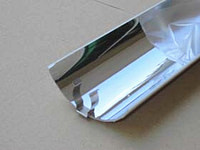 The history of the highest trade protection war between the EU and China in the history of photovoltaics has not only caused anxiety for Chinese companies, but also caused worries about Europe's largest polysilicon producer.
The history of the highest trade protection war between the EU and China in the history of photovoltaics has not only caused anxiety for Chinese companies, but also caused worries about Europe's largest polysilicon producer. At the opening ceremony of Wacker Chemie Shanghai Center last weekend, Dr. Rudolf Staudig, President and CEO of WACKER, received a group interview with the Shanghai Securities News and expressed his hope that the EU government can make a rational decision and hope The Chinese government can not impose punitive tariffs because the trade war has no meaning.
“Avoiding levying punitive tariffs can really solve the problem itself. WACKER has always supported the use of new energy by Chinese companies and China's photovoltaic industry. Therefore, we are actively cooperating with the Ministry of Commerce to provide necessary information data for them to make decisions and hope that China The government can levied no punitive tariffs. Even if punitive tariffs are finally implemented, WACKER will still export to China. Even though the price will be higher, I believe our customers will continue to purchase,†said Staudig.
However, he also denied the need to avoid polysilicon anti-dumping practices by setting up factories in China. “If you start to build polysilicon production bases in China, there will be delays in time, and there is no way to meet the rapidly growing market demand in time. This is not A reasonable solution to the problem," he said.
In his opinion, solving trade barriers through negotiation is the best solution. If punitive tariffs are imposed, Chinese customers will inevitably purchase high-quality polysilicon raw materials at higher prices.
Prior to this, many domestic downstream PV manufacturers also expressed that they did not want to launch anti-dumping against EU polysilicon due to concerns that polysilicon prices would rise, while domestic polysilicon leading enterprises such as GCL-Poly also insisted that the continued decline in polysilicon import prices this year constituted dumping.
Data show that the lowest spot price of polysilicon has dropped to 15 US dollars / kg.
Staudig argued that the current spot price of $15/kg polysilicon does not necessarily reflect the price level achieved between the polysilicon manufacturer and the customer. Because of the excess capacity, companies that purchased a lot of polysilicon at the beginning and caused inventory backlogs urgently needed to handle backlogs to obtain cash.
When talking about the current market situation, he pointed out that there is still a large amount of polysilicon inventory needs to be digested, and the speed of digesting inventory entirely depends on the growth rate of installation of the photovoltaic industry. In 2011, the installed capacity of global photovoltaic industry exceeded 27GW, and it is expected to exceed 30GW in 2012 and 34 to 40GW in the next year, but these may change due to market development. “We think global polysilicon demand will also increase.â€
However, due to market risk considerations, Wacker Chemicals has delayed the expansion of its polysilicon capacity at the Tennessee plant in the United States, involving a capacity of 15,000 tons.
“We have delayed this plan for 18 months and we expect to invest it in the middle of 2015.†Stoddiger said that at the end of the year, the company’s polysilicon production capacity was around 52,000 tons.
Earlier last year, WACKER announced that it will build a new polysilicon production facility in the city of Cleveland, Tennessee. It is expected to be completed and put into production by the end of 2013, with an annual capacity of 15,000 tons. In this way, WACKER's ultra-pure polysilicon production capacity will reach 67,000 tons by 2014.
our fluorescent light reflectors can provide up to 30% more light output than those lined with white paint, solder mask, or powder coat.reflectors are available as a film, tape, or laminated to metal. They are easily and cleanly cut using laser, die, shear, or blade cutters. Shapes can be created with standard thermoforming techniques to line the interior surfaces of luminaires. Metal versions are compatible with shear, punch, roll, and other standard sheet metal processes.

Fluorescent Light Shade,Reflective Light Shade,Aluminum Reflector Shade,2X36W Fluorescent Light Fitting
Changzhou Kema Reflector Material Co., Ltd. , http://www.aluminumreflector.com